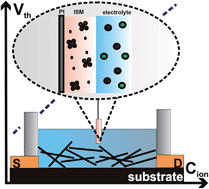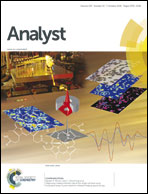Selective ion-sensing with membrane-functionalized electrolyte-gated carbon nanotube field-effect transistors†
Abstract
In this work the ion-selective response of an electrolyte-gated carbon-nanotube field-effect transistor (CNT-FET) towards K+, Ca2+ and Cl− in the biologically relevant concentration range from 10−1 M to 10−6 M is demonstrated. The ion-selective response is achieved by modifying the gate-electrode of an electrolyte-gated CNT-FET with ion-selective membranes, which are selective towards the respective target analyte ions. The selectivity, assured by the ion-selective poly(vinyl chloride) based membrane, allows the successful application of the herein proposed K+-selective CNT-FET to detect changes in the K+ activity in the μM range even in solutions containing different ionic backgrounds. The sensing mechanism relies on a superposition of both an ion-sensitive response of the CNT-network as well as a change of the effective gate potential present at the semiconducting channel due to a selective and ion activity-dependent response of the membrane towards different types of ions. Moreover, the combination of a CNT-FET as a transducing element gated with an ion-selective coated-wire electrode offers the possibility to miniaturize the already well-established conventional ion-selective electrode setup. This approach represents a valuable strategy for the realization of portable, multi-purpose and low-cost biosensing devices.


 Please wait while we load your content...
Please wait while we load your content...